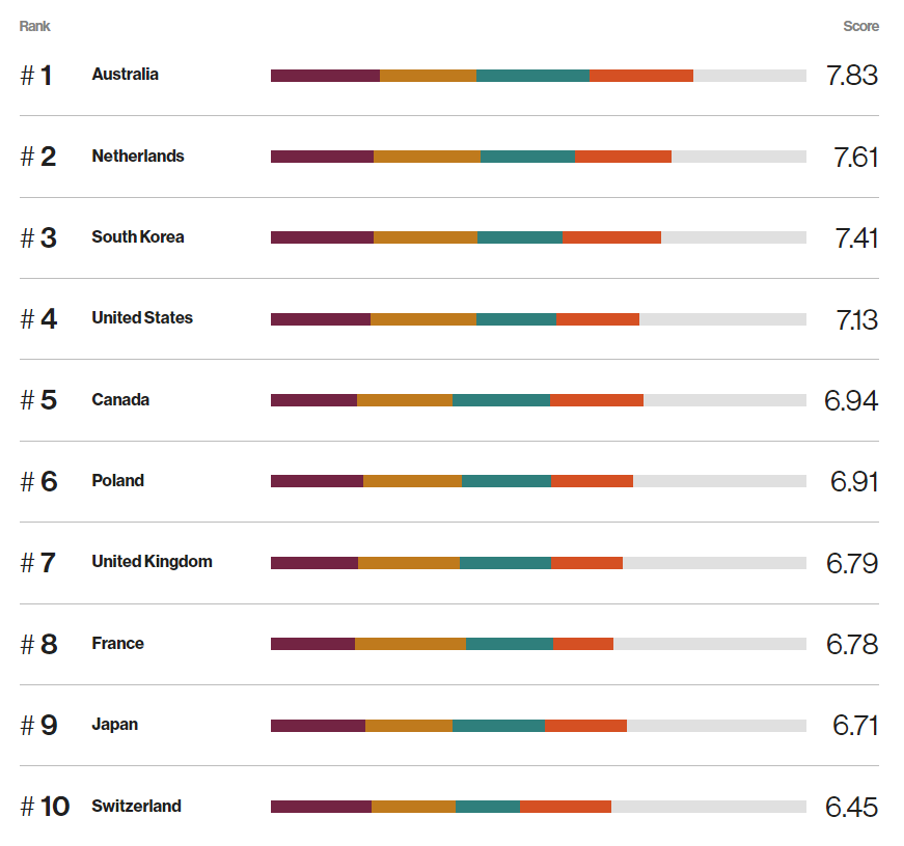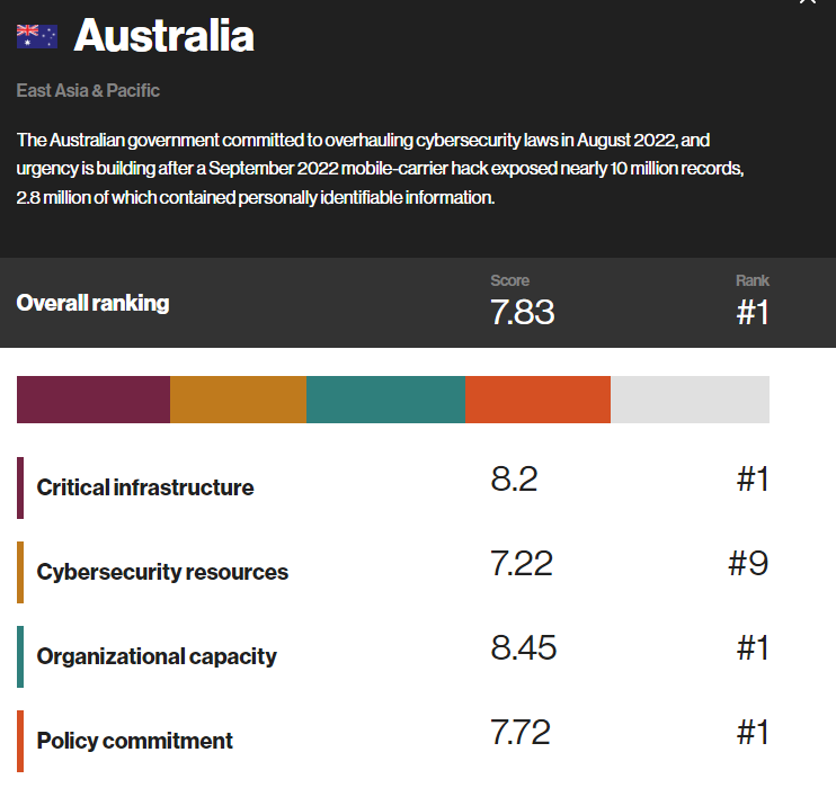
MIT’s Cyber Defense Index
The MIT Technology Review Insights Cyber Defense ranks the countries of the Group of Twenty intergovernmental forum on their cyber defence. It covers:
- The adoption of technology for cyberattack resilience
- The promotion of secure digital transactions within government and policy
Countries are given an overall rank, and a rank against four pillars.
The overall rankings
In terms of the overall ranking, Australia came in at number 1!
The top 10 are:
- Australia
- The Netherlands
- South Korea
- United States
- Canada
- Poland
- United Kingdom
- France
- Japan
- Switzerland
The report said: “Australia’s first-place CDI score reflects efforts to make robust digital infrastructure widely available. The Australian government strives to use digital tools and regulations to safeguard personal data and digital transactions. It committed to overhauling cybersecurity laws, pledging to shelve a previous roadmap.”
It also mentions that this remains true, despite the high-profile attack on Optus.
The pillars
The data is compiled into six individual indicators with weightings assigned based on the importance of the indicator. These 16 indicators were then grouped into four pillars. The four pillars are:
Critical infrastructure: Looking at the security of each country’s digital and telecommunications networks. It measures things like infrastructure capacity, data centres per million people, and secure internet servers. Pillar weighting: 30%
Cybersecurity resources: Rates each country’s protective measures across both technology and law enforcement. It includes things like data privacy and cybersecurity capabilities such as AI and blockchain. Pillar weighting: 35%
Organisational capacity: Measuring cybersecurity maturity, indicators include areas such as how well the private sector and government work together, government AI technology-readiness and the use of industry standard cybersecurity practices. Pillar weighting: 20%
Policy commitment: Looks at each country’s government commitment to, and implementation of, cybersecurity regulation. Indicators include the country’s legislation, policy implementation, and cybersecurity framework. Pillar weighting: 15%
The pillar rankings
Countries were also ranked against each pillar.
Pillar 1 — critical infrastructure:
- Australia
- South Korea
- The Netherlands
- Switzerland
- United States
Pillar 2 — cybersecurity resources:
- France
- The Netherlands
- United States
- South Korea
- Spain
(Australia ranked 9th)
Pillar 3 — organisational capacity:
- Australia
- China
- Canada
- The Netherlands
- Japan
Pillar 4 — policy commitment:
- Australia
- South Korea
- The Netherlands
- Canada
- Switzerland
Insights from the report
The full draws lots of insights from the rankings and data. For example, the importance of geopolitics is mentioned, with examples including the ‘uplift’ all EU countries get from the General Data Protection (GDPR) framework, and the need for South Korea and Poland to be vigilant due to the cyber misconduct of their respective neighbours, North Korea and Russia.
The report also highlights that developing nations are disadvantaged because of lack of investment.
These are only two examples of the insights into the cybersecurity landscape today.
Source data
The index is based on 31 different sets of source data. Some of the source data includes:
- The 2022 Cyber Defense Index Survey (2022) of 1000 senior executives from the 20 countries (equally represented)
- United Nations E-Government
- The World Bank
Salsa Digital’s take
Cyber threats are ever-present in today’s digital world. Over the past 10 years, we've seen cyber incidents grow in sophistication and complexity, beating new security measures as they're deployed. In recent months high-profile cyber attacks on private organisations have made the headlines with Optus and Medibank both falling prey to 'bad-actors' breaching the security measures in place.
With a strong focus on cybersecurity, Salsa works closely with government agencies, building highly secure platforms and websites. An example of this is Salsa's work with GovCMS to certify the GovCMS program via the Information Security Registered Assessors Program (IRAP) (read the GovCMS IRAP certification case study). We also secured authority to operate for another large government portal (read the case study on a federal agency securing authority to operate).
Everyone can play a part in improving cybersecurity by understanding the tools and practices that build resilience. To this end, we share our knowledge by publishing various insights and blogs on security topics. Our Chief Information Officer (CISO) is proactively involved in our work to ensure Salsa can represent and share this knowledge. From simple website projects to whole-of-government platforms, Salsa is ultimately striving to make serving Australian citizens and our clients safer and more cybersecure.



